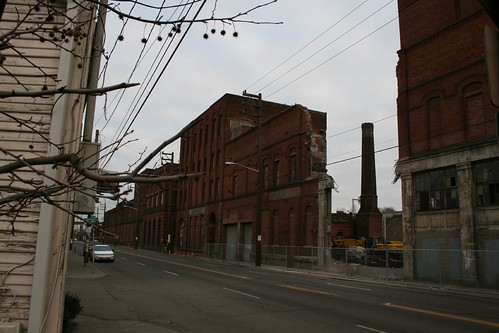2. Jim Harmon did write me back about my Friday e-mail about which "historical preservation principles" made saving the freestanding Brew House wall undesirable.
It's the piece of wall sticking out here in this photo I took in January:

From his Friday e-mail to the neighborhood:
Regarding where we are, the demolition of the Stock House will be
completed in the next few weeks. We have not reached a conclusion as to what to do about the remaining façade wall attached to the Brew House. While that wall does not pose an impending danger like the Stock House did, it does pose the matter of design and cost, as it looked to be several million dollars to retain it. In our discussions with the Landmarks Preservation Board, certain members expressed their desire to keep this façade. Additionally, certain neighborhood members expressed their concern and very much wanted to keep it. However, landmarks regulations recognize that the preservation of certain landmarked elements may be uneconomical and can grant an exception to the preservation rule. Our assertion is that it is not only uneconomic, but that it is undesirable from a design and historic standpoint (and there are certain historic preservation principles that this is based upon).
And from his response to me:
In response to your questions, the principle in question is termed façadism. Below are excerpts from submittals we previously made to the Landmarks Board and posted on our website:
* “We do not believe that retaining this wall is true to historic preservation and constitutes façadism since there is no structure behind it, historic or otherwise. We understand there to be divergent opinions, but façadism is not supported by many and is contrary to federal and local tax incentives, further indication of its standing.”
* “...we do not believe that retaining the North Wall is within the spirit of historic preservation as it constitutes façadism[1], and we see the removal of that wall as an opportunity to open the remaining historic structures to sight from Airport Way as well as reasonable vehicular access into the historic areas.”
* "[1] This point is emphasized by the fact that significant tax incentives are provided to retain historic structures by both federal income tax and local real estate tax credits; however, no such economic incentives are provided for retaining a building façade."
It’s also referred to as facadomy. See Wikipedia reference and citings here http://en.wikipedia.org/wiki/Facadism.
Hmm. I'm no expert, but that Wikipedia link about facadism seems to suggest that preservationists believe that maintaining an entire building is preferable to maintaining just a facade. However, it does NOT seem to suggest that preservationists believe that destroying an existing freestanding facade is preferable to maintaining it. Maybe someone more knowledgeable about historical preservation would like to weigh in?
[Update/sidenote: Here's a 3/25/08 Crosscut article about Seattle's historical landmark designation process.]

There's a building in Belltown I walk by all the time that has the original facade preserved with a modern glass building behind it, but I can't remember the exact address. It's on 2nd Avenue, and the cross-street is somewhere around Bell. It's got a brass plate attached to it explaining the history of the structure, but I've never read it. The facade is Greek Revival.
ReplyDeleteThe effect is kind of like the I.M. Pei addition to the Louvre--jarring and provocative. It would be cool if they could preserve the Stock House wall that way, too.
The building in Belltown is Cristalla. The terracotta façade is a remnant of the Crystal Pool, originally the work of B. Marcus Priteca, probably best known here in Seattle for the Coliseum Theatre, and best known nationally for his many Pantages theaters. For 50 years or so the building was the Bethel Temple. It's kind of funny that a Priteca bathhouse became a place of worship, because two other buildings of his in Seattle were built as places of worship, both synagogues. One is now the Langston Hughes Arts Center; the other (on which he collaborated with two other architects) is the sanctuary of Temple DeHirsch-Sinai.
ReplyDeleteThe debate about "facadism" is unresolved in the preservation community, and the rub is that subsidies are only available for full fledged preservation; a wall would have to be preserved at the expense of the developer. Once again, it boils down to money that Sabey is unwilling to spend. Harmon's remarks that he cares about the principle of preservation is laughable at best. His job is to make money for the company.
ReplyDeleteThere's another great brick bldg at about 1st and Battery in Belltown that also saved the facade in a redevelopment about 6-8 yrs ago. These guys are lying through their teeth if they say they can't save it. But you can bet on it going bye-bye at this point, if it hasn't already. Harmon's responses to your email include reference to the north wall. If I'm not mistaken, the wall shown in your picture is the west wall. I can't see how the north wall would have any aesthetic or historical value, although I can definitely see the west wall having both. Have to agree w/ the "sabey insider" that there's not a snowball's chance that wall will be saved--they perceive it to be too expensive. It actually probably would not be that expensive if a competent structural engineer and contractor were involved, and would add some significant appeal to what is most likely going to be another boring development. Too bad.
ReplyDeleteI'm pretty sure the "North Wall" is the one shown on the south side of the picture. They must mean "North Wall" in relation to the (now demolished) southern Stock House, as opposed to the northern Brew House.
ReplyDelete